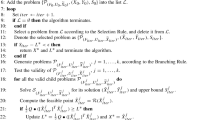Abstract
In this paper, we propose a semidefinite relaxation based branch-and-bound algorithm to the unit-modulus constrained complex quadratic programming problem, which has broad applications in signal processing and wireless communications. Our research is motivated from the potential application of the magnitude least-square problem, which possesses the so-called block-arrow sparsity pattern. We discuss how to reduce the worst-case complexity of the proposed branch-and-bound algorithm by exploiting this special sparsity pattern. Numerical results are presented to show the effectiveness of the proposed algorithm.





Similar content being viewed by others
Notes
In general, an angle \(\tau \) can be any real number, without the requirement of \(\tau \in (-\pi ,\pi ]\).
Each edge in the graph \(\mathcal {F}\) has a length of one, and the length of a path equals the number of edges in the path.
References
Arora, A., Tsinos, C.G., Bhavani Shankar, M.R., Chatinotas, S., Ottersten, B.: Efficient algorithms for constant-modulus analog beamforming. IEEE Trans. Signal Process. 70, 756–771 (2022)
Azuma, G., Fukuda, M., Kim, S., Yamashita, M.: Exact SDP relaxations of quadratically constrained quadratic programs with forest structures. J. Glob. Optim. 82, 243–262 (2022)
Azuma, G., Fukuda, M., Kim, S., Yamashita, M.: Exact SDP relaxations for quadratic programs with bipartite graph structures. J. Glob. Optim. 2022, 1–21 (2022)
Bandeira, A.S., Boumal, N., Singer, A.: Tightness of the maximum likelihood semidefinite relaxation for angular synchronization. Math. Program. 163(1–2), 145–167 (2017)
Boumal, N.: Nonconvex phase synchronization. SIAM J. Optim. 26(4), 2355–2377 (2016)
Chen, C., Atamtürk, A., Oren, S.S.: A spatial branch-and-cut method for nonconvex QCQP with bounded complex variables. Math. Program. 165(2), 549–577 (2017)
Fukuda, M., Kojima, M., Murota, K., Nakata, K.: Exploiting sparsity in semidefinite programming via matrix completion I: general framework. SIAM J. Optim. 11(3), 647–674 (2001)
Jaldén, J., Martin, C., Ottersten, B.: Semidefinite programming for detection in linear systems–Optimality conditions and space-time decoding. In: Proceedings 2003 IEEE international conference on acoustics, speech, and signal processing (ICASSP), pp. 9–12 (2003)
Kassakian, P.W.: Convex approximation and optimization with applications in magnitude filter design and radiation pattern analysis. PhD Dissertation, Department of EECS, University of California, Berkeley (2006)
Kim, S., Kojima, M., Mevissen, M., Yamashita, M.: Exploiting sparsity in linear and nonlinear matrix inequalities via positive semidefinite matrix completion. Math. Program. 129(1), 33–68 (2001)
Kocvara, M.: Decomposition of arrow type positive semidefinite matrices with application to topology optimization. Math. Program. 190(1–2), 105–134 (2021)
Lu, C., Deng, Z., Zhang, W.Q., Fang, S.C.: Argument division based branch-and-bound algorithm for unit-modulus constrained complex quadratic programming. J. Glob. Optim. 70(1), 171–187 (2018)
Lu, C., Liu, Y.F.: An efficient global algorithm for single-group multicast beamforming. IEEE Trans. Signal Process. 65(14), 3761–3774 (2017)
Ma, W.K., Ching, P.C., Ding, Z.: Semidefinite relaxation based multiuser detection for \(M\)-ary PSK multiuser systems. IEEE Trans. Signal Process. 52(10), 2862–2872 (2004)
Maio, A.D., Huang, Y., Piezzo, M., Zhang, S., Farina, A.: Design of optimized radar codes with a peak to average power ratio constraint. IEEE Trans. Signal Process. 59(6), 2683–2697 (2011)
Maio, A.D., Nicola, S.D., Huang, Y., Luo, Z.Q., Zhang, S.: Design of phase codes for radar performance optimization with a similarity constraint. IEEE Trans. Signal Process. 57(2), 610–621 (2009)
Mosek: Mosek ApS. http://www.mosek.com (2020)
Nakata, K., Fujisawa, K., Fukuda, M., Kojima, M., Murota, K.: Exploiting sparsity in semidefinite programming via matrix completion II: implementation and numerical results. Math. Program. 95(2), 303–327 (2003)
Singer, A.: Angular synchronization by eigenvectors and semidefinite programming. Appl. Comput. Harmon. Anal. 30(1), 20–36 (2011)
So, A.M.C.: Probabilistic analysis of the semidefinite relaxation detector in digital communications. In: Proceedings of the twenty-first annual ACM-SIAM symposium on discrete algorithms (SODA’10), pp. 698–711 (2010)
Sojoudi, S., Lavaei, J.: Exactness of semidefinite relaxations for nonlinear optimization problems with underlying graph structure. SIAM J. Optim. 24(4), 1746–1778 (2014)
Soltanalian, M., Stoica, P.: Designing unimodular codes via quadratic optimization. IEEE Trans. Signal Process. 62(5), 1221–1234 (2014)
Tan, P.H., Rasmussen, L.K.: The application of semidefinite programming for detection in CDMA. IEEE J. Sel. Areas Commun. 19(8), 1442–1449 (2001)
Tranter, J., Sidiropoulos, N.D., Fu, X., Swami, A.: Fast unit-modulus least squares with applications in beamforming. IEEE Trans. Signal Process. 65(11), 2875–2887 (2017)
Vandenberghe, L., Andersen, M.: Chordal graphs and semidefinite optimization. Found. Trends Optim. 1(4), 241–433 (2015)
Waldspurger, I., d’Aspremont, A., Mallat, S.: Phase recovery, MaxCut and complex semidefinite programming. Math. Program. 149(1–2), 47–81 (2015)
Zhang, R.Y., Lavaei, J.: Sparse semidefinite programs with guaranteed near-linear time complexity via dualized clique tree conversion. Math. Program. 188(1), 351–393 (2021)
Zhang, S., Huang, Y.: Complex quadratic optimization and semidefinite programming. SIAM J. Optim. 16(3), 871–890 (2006)
Zheng, Y., Fantuuzzi, G., Papachristodoulou, A., Goulart, P., Wynn, A.: Chordal decomposition in operator-splitting methods for sparse semidefinite programs. Math. Program. 180(1–2), 489–532 (2020)
Author information
Authors and Affiliations
Corresponding author
Additional information
Publisher's Note
Springer Nature remains neutral with regard to jurisdictional claims in published maps and institutional affiliations.
Lu’s research has been supported by National Natural Science Foundation of China Grant No. 12171151. Deng’s research has been supported by the National Natural Science Foundation of China Grant No. T2293774, by the Fundamental Research Funds for the Central Universities E2ET0808X2, and by the grant from MOE Social Science Laboratory of Digital Economic Forecast and Policy Simulation at UCAS. Xing’s research has been supported by National Natural Science Foundation of China Grant No. 11771243.
Rights and permissions
Springer Nature or its licensor (e.g. a society or other partner) holds exclusive rights to this article under a publishing agreement with the author(s) or other rightsholder(s); author self-archiving of the accepted manuscript version of this article is solely governed by the terms of such publishing agreement and applicable law.
About this article
Cite this article
Lu, C., Ma, J., Deng, Z. et al. A graphic structure based branch-and-bound algorithm for complex quadratic optimization and applications to magnitude least-square problem. J Glob Optim 88, 115–137 (2024). https://doi.org/10.1007/s10898-023-01305-9
Received:
Accepted:
Published:
Issue Date:
DOI: https://doi.org/10.1007/s10898-023-01305-9




